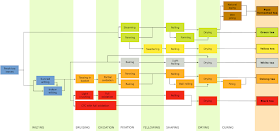Today we will consider hot beverages - without which most people would stay in bed, or fall asleep at their desks.
Do we need any math skills to understand these drinks?
With a cup of hot coffee or tea, the groggy sleeper ingests some warmth, some caffeine, some flavor and some aroma - and perhaps a few calories. There are plenty of other hot drinks in the world - infusions and heated spirits and hot chocolate, but coffee and tea are the two favorites.
Neither of these beverages has much nutritional value. We get no calories, no fat, no protein, but coffee is apparently a good source of Pantothenic Acid, and a very good source of Riboflavin, while tea is a very good source of Manganese. Both contain caffeine, with coffee supplying 2-3 times caffeine as much as tea.
Neither of these beverages can be easily made at home, from scratch. You can't grow the plants or prepare the raw materials yourself unless you live in certain tropical regions. [click images to enlarge]
But looking at the production process or chemical content doesn't tell us why people drink either one. There's plenty of intangible value to be obtained from some human activities, even when that value can't be quantified by the scientists.
NOTE - For detailed nutritional statistics on brewed, un-blended beverages made with tap water, check here for coffee, and here for tea.
COFFEE
I don't drink coffee myself, so I can't speak to its intangible virtues. But I can certainly see people all around me who enjoy it. Historians tell us this has been the case for about 5 centuries. How much do these coffee lovers drink?
- I found estimates suggesting half the US population of 310 million drinks coffee, and the average drinker consumes 3.2 cups per day, so ( 310 ÷ 2 ) x 3.2 = 496 million cups
- Other sources told me 400 million cups a day
TEA
The tea drinkers of the world, and I am one, find pleasure in drinking tea. We have been doing so for about 30 centuries! We have been taking a short break with it, blending it, sweetening it, diluting it with milk and cream, washing down cookies and cakes with it, and so on. How much do we drink?
- I found that tea drinkers comprise 66% of the 65 million people in the UK and each consumes about 3 cups per person daily. That means ( 65 x .66 ) x 3 = 128 million cups
- The Tea Council says the number is 165 million cups a day
It's amazing that all this activity centers around pouring heated water over some leaves, isn't it? Ok, it's a bit more involved than that, but still, it's hot water and plant leaves. And some math.




